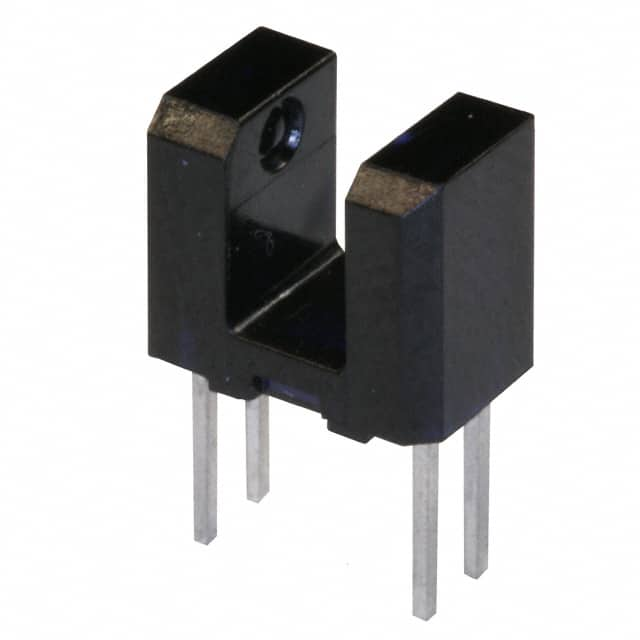Viz Specifikace pro podrobnosti o produktu.

OPB610
Product Overview
The OPB610 belongs to the category of optical sensors and is commonly used for detecting the presence or absence of an object. Its characteristics include high sensitivity, compact size, and reliable performance. The package consists of a sensor and emitter in a single housing, making it easy to integrate into various applications. The essence of OPB610 lies in its ability to provide accurate and consistent object detection. It is typically available in standard packaging with varying quantities to suit different project requirements.
Specifications
- Operating Voltage: 4.5V to 5.5V
- Output Configuration: Phototransistor
- Sensing Distance: Up to 0.2 inches (5.08mm)
- Operating Temperature Range: -40°C to 85°C
- Package Type: Through Hole
- Package / Case: 4-DIP (0.400", 10.16mm)
Detailed Pin Configuration
The OPB610 features a 4-pin configuration: 1. VCC (Power Supply) 2. GND (Ground) 3. Output 4. N/C (Not Connected)
Functional Features
The OPB610 operates by emitting infrared light from the emitter, which is then detected by the phototransistor when an object is present within the sensing distance. This triggers the output signal, indicating the presence of the object.
Advantages and Disadvantages
Advantages
- High sensitivity
- Compact size
- Reliable performance
- Easy integration
- Wide operating temperature range
Disadvantages
- Limited sensing distance
- Susceptible to ambient light interference
Working Principles
When powered, the emitter emits infrared light, which is then received by the phototransistor. When an object enters the sensing distance, the emitted light is reflected back to the phototransistor, causing it to conduct and produce an output signal.
Detailed Application Field Plans
The OPB610 finds extensive application in various fields such as: - Object detection in industrial automation - Paper and print media handling in printers - Robotics for object proximity sensing - Vending machines for product detection - Security systems for intrusion detection
Detailed and Complete Alternative Models
Some alternative models to OPB610 include: - TCRT5000: Similar functionality with a different package type - QRE1113: Reflective object sensor with comparable specifications - GP2Y0A21YK: Longer sensing distance with integrated analog output
In conclusion, the OPB610 optical sensor offers reliable object detection capabilities with its compact design and high sensitivity. While it has limitations in sensing distance and susceptibility to ambient light, it remains a popular choice for various applications in industrial automation, robotics, and security systems.
Word Count: 366
Seznam 10 běžných otázek a odpovědí souvisejících s aplikací OPB610 v technických řešeních
What is OPB610?
- OPB610 is a reflective object sensor that consists of an infrared LED and a phototransistor.
How does OPB610 work?
- The infrared LED emits light, which is then reflected off an object and detected by the phototransistor, allowing it to sense the presence or absence of the object.
What are the typical applications of OPB610?
- OPB610 is commonly used in applications such as robotics, industrial automation, and assembly line monitoring for object detection and counting.
What is the operating voltage range for OPB610?
- The operating voltage range for OPB610 is typically between 4.5V and 5.5V.
What is the sensing distance of OPB610?
- The sensing distance of OPB610 can vary based on the specific application and environmental conditions, but it is generally in the range of a few millimeters to a few centimeters.
Can OPB610 be used in outdoor environments?
- OPB610 is primarily designed for indoor use and may not perform optimally in outdoor environments due to factors such as ambient light and weather conditions.
What is the output type of OPB610?
- OPB610 provides a digital output, typically in the form of a logic high or low signal based on the presence or absence of the detected object.
Is OPB610 sensitive to ambient light?
- OPB610 is designed to minimize the impact of ambient light through its modulation and demodulation techniques, but excessive ambient light can still affect its performance.
Can OPB610 detect transparent objects?
- OPB610 may have difficulty detecting transparent objects, as they may not reflect sufficient infrared light to be reliably detected.
What are the key considerations for integrating OPB610 into a technical solution?
- When integrating OPB610, it's important to consider factors such as mounting position, ambient light levels, object reflectivity, and electrical interfacing to ensure reliable and accurate operation.

